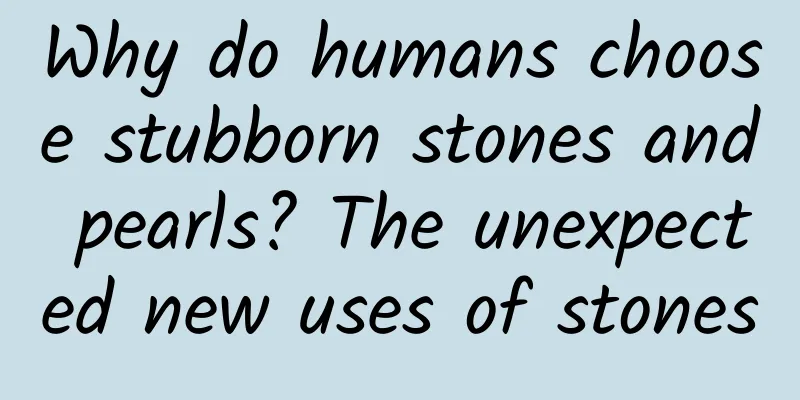Why do humans choose stubborn stones and pearls? The unexpected new uses of stones

|
Humans are naturally fond of stones. As descendants of highly evolved arboreal animals, humans have acquired the ability to manipulate tools during evolution, and stone was the earliest material used for tools. After the human brain evolved further, stone also had an "unexpected" new use - aesthetics. Since aesthetic standards are relatively subjective, human aesthetics has also undergone a series of changes in the long course of history, and has produced significant differences with the evolution of different cultures. But at least at the beginning, the aesthetic "basic template" of primitive humans was relatively consistent: in their view, anything colorful, sparkling, and with a rare shape was beautiful, and many stones just had these characteristics. 1The earliest choice: Ochre and Malachite The first stones that people "loved" for aesthetic reasons were probably ochre and malachite exposed on the surface. The former contains a lot of ferric oxide, while the latter contains a lot of copper oxide. Before the discovery of metal smelting technology, these two minerals were widely used as pigments by residents all over the world, including the ancient Chinese. The red and green powders made from them after grinding appeared in large quantities in various places, from murals to tombs, and their applications were very wide. Therefore, most of the uses of ochre and malachite at that time were actually used as pigments after grinding, rather than for viewing alone. 2. The Real “Gem”: Jade The "stone" that is truly collected as a "gem" and even given a specific social significance is actually jade. Image source: Pixabay Although most jades are just a mixture of aluminum oxide and silicate, and are not very rare, their color and smooth and hard texture easily attract people's love. As early as 7,000-8,000 years ago in the Neolithic period, the primitive inhabitants of ancient China began to make jade. The first jades were simple ornaments with a hole in the middle (for threading), but soon, people processed jade into various patterns: in the Liangzhu culture era, jades had already appeared more complex patterns and were polished into rings, tubes, beads, cong (cóng) and other forms. During the Erlitou culture period, jade artifacts in the form of knives, daggers, and jade gui appeared. Of course, although Confucius later claimed that "in the time of Huangdi, jade was used as weapons", these jade weapons were more likely to be religious or ceremonial tools rather than practical items. After the Shang Dynasty, jade was widely used as a material for various sculptures. In the ruins of this era, a large number of jade statues of people, animals, and even ghosts can often be found. As the demand for jade gradually increased, the limited jade reserves in East Asia gradually failed to meet the demand. As a result, Asia’s earliest large-scale "international trade" route, the "Jade Road", was formed. This trade route, which was earlier than the "Silk Road" proposed by Richthofen, was not a specific route, but a holistic description of the East Asia-Central Asia trade activities at that time: jade (such as Hetian jade and topaz) and other gemstones (such as lapis lazuli from Afghanistan) from Central Asia were carried by early merchants and gradually entered East Asia through repeated trade. Some jade also came from the trading route of the Yunnan-Guizhou Plateau in the south. For example, a lot of jadeite (jadeite) was mined in Myanmar and transported to China along the southern trade route. 3Hobbies of the nobility: Crystal During the Shang and Zhou dynasties, with the concentration of wealth and the development of processing technology, another kind of "stone" began to enter the vision of the powerful class - crystal. Image source: Pixabay This natural silicon dioxide crystal began to be sought after because of its transparent color and rare characteristics. Until now, we can still find in museums that sometimes a very "modern" "glass cup" or "glass cup" will appear on the exhibition booth marked with the "Warring States Period", which looks like some kind of prank. But in fact, these objects were indeed carefully polished from a whole piece of crystal by craftsmen thousands of years ago. Generally speaking, crystals with pure texture and no bubbles or impurities are considered top quality and are used to make luxury utensils for kings and nobles. Crystals with red, blue, purple and other hues due to trace amounts of iron and aluminum are processed into less important ornaments. 4Exotic treasures: imported gemstones With the deepening of East-West trade after Zhang Qian opened up the Western Regions, some gemstones that were popular in Western society, such as emeralds and rubies, which came from Transoxiana (now the Amu Darya River Basin) and Persia, also appeared in the treasure houses of Chinese dignitaries as exotic treasures, and the proportion is still increasing. After the Tang and Song dynasties, gemstones had even become a relatively important category, occupying a significant part of China's foreign trade (but still not comparable to spices and textiles, which were the main commodities). In the Song Dynasty Zhao Ruoshi's geographical and natural history book "Zhufan Zhi", we can get a glimpse of some imported gemstones in the lower volume (the "Zhiwu" volume). The book mentioned "Mao'erjing" (cat's eye stone) from the Danshui River in Nanpi State, and believed that this gemstone was the product of "stars shining on the land, and the air was fine and knotty", while natural green column jade from the Middle East and artificially fired lead-barium glass with emerald green color were called "Liuli" and regarded as the same type of gemstone. Interestingly, in this book, coral is also regarded as a kind of gemstone - of course, it is not wrong to say so. After all, the calcareous skeletons left behind by the growth of coral polyps can indeed be regarded as a kind of "stone", and the corals collected in the Mediterranean and the Red Sea often become an important means for the wealthy in the Central Plains to show off their wealth. In the famous story of Shi Chong's competition for wealth, one of the treasures shown by both parties was coral. Because it is difficult to transport and preserve, the larger and taller the coral is, the better the price it can sell for. 5. The need for garden viewing: rockery It is worth mentioning that in addition to the "gems" in the general sense, due to the development of garden construction technology, another demand for ornamental stones has also begun to emerge - rockery stones. In order to build rockery with various shapes in the garden, the rich and powerful often like those stones with strange shapes and holes, and the easily eroded limestone just meets the above needs. This type of limestone is usually formed in two ways: the so-called "dry stone" is usually formed gradually under the slow erosion of acidic red soil; and the so-called "water stone" is produced by erosion in water. Among all kinds of rockery stones, Taihu stone is relatively famous, but the origin of rockery stones is far more than Taihu Lake. After all, high-quality stones are always in short supply. In addition, the rise of bonsai has also created a demand for similar stones. Many broken stones that were originally fragments of mountains in karst landforms have been transformed into "peaks" of different sizes after processing. 6The choice of scholars: inkstone Another type of stone that was once particularly popular among the Chinese was the inkstone used for inkstones. Due to the ancient Chinese's extreme admiration for literature and culture, this originally ordinary tool for grinding and storing ink became more and more sophisticated, with more and more decorations and carvings, and its raw materials naturally embarked on a path of continuous improvement. Generally speaking, excellent inkstone stones are considered to be sedimentary and metamorphic rocks that are strong, fine-grained, not easy to crack, and have high density, so that they can be easily processed and stored. After centuries of competition and evolution, several relatively famous inkstone stones have appeared on the market, such as Duanshi, Sheshi, Taoshi, and Hongsishi. In addition, for those who like to be elegant but don't have a big budget, some relatively cheap ornamental stones are also good choices. One of them is the Yuhua Stone, which is said to have a "long history" but in fact it was only gradually known in the Ming and Qing Dynasties. This round natural agate has a large output and is not expensive, but it has good color and complex patterns, which is quite suitable as a decoration for the indoor environment. After entering the modern era, with the development of the world market, the integration of global consumption and aesthetics, and the decline of traditional culture, the concept of "gems" in the eyes of the Chinese has gradually begun to converge with that of foreign countries, and even in recent decades, there has been a tendency to "only respect diamonds". However, the traditional stone and jade culture has not disappeared. Although we cannot confirm what these cultures will look like in the future, the only thing we can be sure of is that no matter where we are, human aesthetics are always in a process of continuous development and evolution under the premise of self-inheritance. Source: Chongqing Science and Technology Museum Author: Sokhov Review experts: Huang He, Li Chunli, Chen Tao, Xu Xiaoping Statement: Except for original content and special notes, some pictures are from the Internet. They are not for commercial purposes and are only used as popular science materials. The copyright belongs to the original authors. If there is any infringement, please contact us to delete them. |
>>: Taking a step back, is it really true that Leopard cannot be hugged?
Recommend
How to read the KDJ line "KDJ indicator technical tactics" KDJ indicator usage skills detailed video tutorial
Training course video content introduction: The K...
Several valid reasons for refusing to fix a bug
A bug occurs when something doesn't work as e...
Case analysis of information flow promotion in the automotive industry
As an information flow person in the automotive i...
This satellite can be called the "eyes" and "brains" for analyzing carbon dioxide changes
Produced by: Science Popularization China Author:...
From 0 to 1 users, how to do a good job in seed-stage user growth operations?
The product operation cycle is generally divided ...
Is the customization cost of Changsha Photo Mini Program high? Changsha photo app customization cost and process
The launch of mini programs has brought convenien...
A brief history of operations: Understand the 20 years of development and evolution of Internet operations in one article!
Preface Operations is an interesting thing. As on...
7 techniques to explain QQ group marketing and WeChat group marketing!
Groups are an Internet product with a relatively ...
Taobao promotion: Taobao mobile search traffic rules
How is Taobao Mobile search traffic distributed? ...
How to use the "expert" economy, which is more lethal than "Internet celebrities", to market products
Jiuzhilan Interview: A one-stop strategy for buil...
@Everyone! Tips for "emergency handling" during May Day travel are waiting for you to check
The May Day holiday is coming, and many people mu...
The most elite Eight Banners soldiers, from the Solon and Dahur soldiers outside the Great Wall, still went to fight in the Dzungar at the age of 80.
Now when people mention the Eight Banners soldier...
You can’t build a good brand just by focusing on ROI
This article will analyze from the perspective of...
All the copywriting skills were learned in junior high school!
The articles I write are more about copywriting c...









